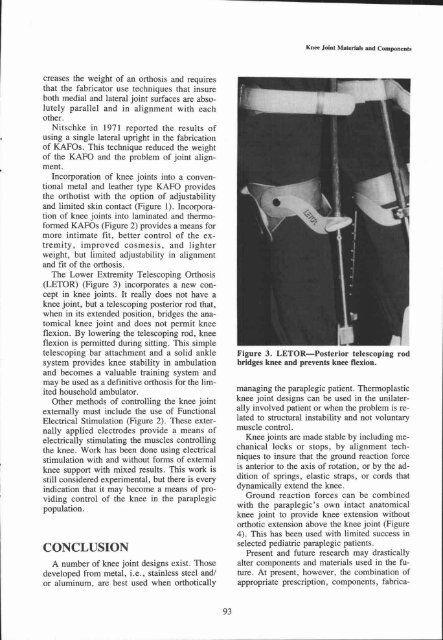View Complete Issue PDF
View Complete Issue PDF
View Complete Issue PDF
You also want an ePaper? Increase the reach of your titles
YUMPU automatically turns print PDFs into web optimized ePapers that Google loves.
creases the weight of an orthosis and requires<br />
that the fabricator use techniques that insure<br />
both medial and lateral joint surfaces are absolutely<br />
parallel and in alignment with each<br />
other.<br />
Nitschke in 1971 reported the results of<br />
using a single lateral upright in the fabrication<br />
of KAFOs. This technique reduced the weight<br />
of the KAFO and the problem of joint alignment.<br />
Incorporation of knee joints into a conventional<br />
metal and leather type KAFO provides<br />
the orthotist with the option of adjustability<br />
and limited skin contact (Figure 1). Incorporation<br />
of knee joints into laminated and thermoformed<br />
KAFOs (Figure 2) provides a means for<br />
more intimate fit, better control of the extremity,<br />
improved cosmesis, and lighter<br />
weight, but limited adjustability in alignment<br />
and fit of the orthosis.<br />
The Lower Extremity Telescoping Orthosis<br />
(LETOR) (Figure 3) incorporates a new concept<br />
in knee joints. It really does not have a<br />
knee joint, but a telescoping posterior rod that,<br />
when in its extended position, bridges the anatomical<br />
knee joint and does not permit knee<br />
flexion. By lowering the telescoping rod, knee<br />
flexion is permitted during sitting. This simple<br />
telescoping bar attachment and a solid ankle<br />
system provides knee stability in ambulation<br />
and becomes a valuable training system and<br />
may be used as a definitive orthosis for the limited<br />
household ambulator.<br />
Other methods of controlling the knee joint<br />
externally must include the use of Functional<br />
Electrical Stimulation (Figure 2). These externally<br />
applied electrodes provide a means of<br />
electrically stimulating the muscles controlling<br />
the knee. Work has been done using electrical<br />
stimulation with and without forms of external<br />
knee support with mixed results. This work is<br />
still considered experimental, but there is every<br />
indication that it may become a means of providing<br />
control of the knee in the paraplegic<br />
population.<br />
CONCLUSION<br />
A number of knee joint designs exist. Those<br />
developed from metal, i.e., stainless steel and/<br />
or aluminum, are best used when orthotically<br />
Figure 3. LETOR—Posterior telescoping rod<br />
bridges knee and prevents knee flexion.<br />
managing the paraplegic patient. Thermoplastic<br />
knee joint designs can be used in the unilaterally<br />
involved patient or when the problem is related<br />
to structural instability and not voluntary<br />
muscle control.<br />
Knee joints are made stable by including mechanical<br />
locks or stops, by alignment techniques<br />
to insure that the ground reaction force<br />
is anterior to the axis of rotation, or by the addition<br />
of springs, elastic straps, or cords that<br />
dynamically extend the knee.<br />
Ground reaction forces can be combined<br />
with the paraplegic's own intact anatomical<br />
knee joint to provide knee extension without<br />
orthotic extension above the knee joint (Figure<br />
4). This has been used with limited success in<br />
selected pediatric paraplegic patients.<br />
Present and future research may drastically<br />
alter components and materials used in the future.<br />
At present, however, the combination of<br />
appropriate prescription, components, fabrica-

















